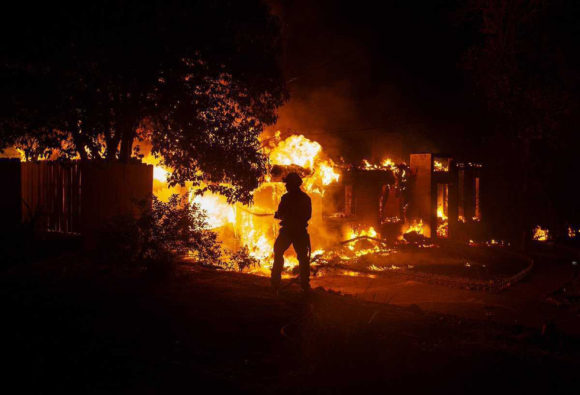PG&E Corp. investors looking to learn their fate may not get the answer from the bankrupt power company. Instead, the key data point could pop up within days on the website of California’s forestry service.
That’s where firefighters are tracking how many structures the Kincade Fire has destroyed — 123 as of late Monday. If the tally tops 500, and it turns out that PG&E equipment started the fire, the backers of two competing reorganization plans for the San Francisco-based utility giant have the right to withdraw because of the soaring liability.
The collapse of those efforts could lead to painful losses for junior bondholders, and all but assure that stockholders get wiped out.
“Everybody has been worried about these financing outs, where both parties have the ability to walk away if there is a large fire,” said Jared Ellias, a bankruptcy law professor at the University of California Hastings. Both groups can re-evaluate whether this is “the world they thought they would be in when they made these commitments.”
The Kincade Fire is raging across more than 70,000 acres, according to the website of California’s Department of Forestry & Fire Protection, forcing thousands of people to flee. PG&E said that one of its transmission lines failed near the origin of the Kincade fire shortly before it was reported to have started. The stock fell 24% Monday, and some of PG&E’s bonds plunged about 15 cents on the dollar.
“The market reaction indicates that all the plans are off the table and that par recovery on the bonds is somewhat in question,” wrote Cantor Fitzgerald Managing Director Terran Miller in a Monday report.
In the short term, it’s unlikely that the rivals will completely give up their efforts to take PG&E out of bankruptcy, Ellias said. “They both spent a lot of time working on this,” he said.
But if the fire expands much more, the damage estimates that underpin their proposals will be way too low. The 500-building threshold gives sponsors a way to scrap their commitments and try to craft a revised restructuring plan.
PG&E and a group of its bondholders are pushing competing versions of a reorganization plan for the court to consider. The utility is dueling with creditors that include Pacific Investment Management Co. and Elliott Management Corp.
Both plans hinge largely on reaching settlements with victims of past fires and their insurers. And both could fall apart if the Kincade fire claims get too large, because new claims get more priority for payment in bankruptcy than any existing unsecured debts.
This means the $30 billion worth of existing wildfire liabilities that PG&E took into its Chapter 11 case would lose priority. In turn, this would push unsecured bondholders and stockholders even lower in the pecking order. Since share owners are among the last to be paid, there may be little or nothing left for them.
The information in the company’s initial report on what happened with its power line before the start of the Kincade fire is “preliminary,” said James Noonan, a PG&E spokesman. “Both PG&E and Cal Fire are conducting investigations,” Noonan said. “It’s too soon to discuss liability for a fire that does not yet have an official determination of cause.”
Representatives for the shareholders committee, which supports PG&E’s restructuring plan, declined to comment, as did the ad hoc committee of unsecured creditors sponsoring the alternative plan.
“Nobody factored in the value of new claims” in their financing commitments, said Cecily Dumas, a lawyer representing the official committee of tort claimants. While neither group of investors had indicated they will pull out, Dumas sees shareholders as more likely to exit. “If their stock value is wiped out, they have less incentive to put new money in because they aren’t protecting anything anymore,” she said.
At the beginning of the bankruptcy, Judge Dennis Montali called the prospect of new wildfire claims the hidden “elephant” in PG&E’s reorganization. In a March hearing, Montali raised the question of whether lenders funding the company’s bankruptcy could declare the multibillion financing package in default because of new fire claims.
Damage Control
PG&E does have ways to mitigate the financial damage. The company had $430 million in insurance coverage for a fire that occurs between Aug. 1 and July 30, 2020, and said it was pursuing additional coverage, according to an Aug. 9 regulatory filing.
The company can also tap into a new state-backed wildfires insurance fund to cover about 40% of the cost of the blaze if it exits bankruptcy by June 30.
What’s more, legislation passed earlier this year allows PG&E to pass costs along to ratepayers if it can prove its conduct was considered reasonable.
It’s also seeking to have the federal bankruptcy judge in charge of its case void state court rulings that say the utility is akin to a public entity and should pay damages under the concept of “inverse condemnation.” The utility should recover the costs by raising the electric rates, the state courts have said.
But California regulators have plainly said they won’t allow that to happen, according to a motion that PG&E filed on Monday in the bankruptcy court, supported by bondholders and shareholders. This conundrum is fueling “a broad consensus that inverse condemnation law in California is broken,” the company said.
–With assistance from Scott Deveau and Jeannine Amodeo.
Was this article valuable?
Here are more articles you may enjoy.


 Musk’s xAI Faces California AG Probe Over Grok Sexual Images
Musk’s xAI Faces California AG Probe Over Grok Sexual Images  Surging Oil Tanker Insurance Points to Growing Black Sea Chaos
Surging Oil Tanker Insurance Points to Growing Black Sea Chaos  Tesla, EEOC Plan Talks to Settle Factory Racism Suit
Tesla, EEOC Plan Talks to Settle Factory Racism Suit  Billionaire NFL Owner Suing Over Billboards Near His SoFi Stadium
Billionaire NFL Owner Suing Over Billboards Near His SoFi Stadium 